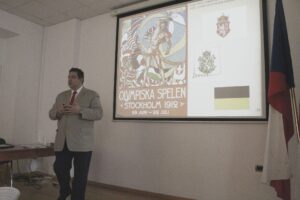The Croatian-Czech Society, the Czech Beseda Zagreb, the Coordination of Croatian Friendship Societies and the Croatian Heraldry and Flag Society marked the 100th anniversary of the Czech flag on Tuesday, June 23, at the Czech National House in Zagreb with a lecture given by Lietenant Colonel Dr. Željko Heimer, President of the Croatian Heraldry and Flag Society (HGZD) and the International Federation of Vexillological Associations (FIAV). It was the 17th lecture in the cycle Flag – the Identity of Peoples and States, which since 2018 is organized by the Coordination of Croatian Friendship Societies with the aim of presenting the vexillological heritage and identity symbols of friendly peoples. The patron of the cycle is the President of the Republic of Croatia, Zoran Milanović.
Speaking of the first Czech symbols, Heimer mentioned as the oldest coat of arms an eagle with flames that appears in the 11th century, and whose introduction as a symbol was attributed to the Czech prince Saint Wenceslas from the 10th century. After the Czech prince Vladislav II in 1158 he received the hereditary royal title from the Roman-German Emperor Frederick I Barbarossa, and the present-day Czech coat of arms, a white lion on a red field that has been depicted with a double tail since 1247, began to be used. The oldest depiction of such a coat of arms, from 1270, is found in Krems, Germany. In the 15th century, the Hussites began to use the chalice and the goose as their symbol (as a symbol of Jan Hus because husa in Czech means goose) which they display on their shields of a specific shape. Such a shield is called a Hussite shield in heraldry, and it is interesting that the coats of arms of Croatian countries on the coat of arms of the Republic of Croatia are shown within such a shield.
At the time of the 1848 revolution, unlike most other Slavic peoples who took tricolors, the Czechs began to use the two-color red and white flag as their flag. As a curiosity, Heimer mentioned the flag with the Czech coat of arms on a white background used by Czech athletes at the 1912 Stockholm Olympics.
At the time of the First World War, when the struggle for the creation of a joint Czech-Slovak state began, its flag began to be designed. In addition to the pan-Slavic colors white, blue and red, which have been used by the Slovaks as their flag since 1848, there are also versions of the white-red flag with the Czech crown, with the coats of arms of Bohemia, Moravia, Silesia and Slovakia. These flags were used by Czechoslovak volunteer legions that fought on the side of the Entente. At the same time, a flag with a wide blue field bordered by narrower red-white and white-red fields, with four stars in the blue field, is being created in the United States. With the creation of independent Czechoslovakia in 1918, the white-red flag proved impractical because it was identical to the flag of newly formed Poland and similar to the flag of Monaco and several German and Austrian countries. Therefore, in 1919, a new flag was made, and among numerous proposals, on March 30, 1920, the white-red flag with a blue wedge in the left half, designed by Jaroslav Kursa, was finally accepted as the official flag of Czechoslovakia. This flag was used until the cessation of Czechoslovakia in 1992, and at the same time there was no official flag of the Czech Republic as part of a common state, until 1990 when the white-red flag was adopted. Although the agreement between the Czech Republic and Slovakia on peaceful separation agreed that neither of the two federal republics would use the symbols of the additional federation, in 1993 the independent Czech Republic took the Czechoslovak flag as its flag. In his lecture, Heimer also spoke about the coats of arms and flags of Moravia and Silesia, as well as 16 Czech regions (regions) and individual cities, and also presented the flags of the Czechoslovak and Czech navies.

From left to right: Juraj Bahnik (Czech Beseda Zagreb), Željko Heimer (HGZD), H. E,. Mr. Vladimír Zavázal, Ambassador of the Czech Republic, Andrija Karafilipović (KHDP), Marijan Lipovac (Croatian Czech Society).
The Czech Ambassador Vladimír Zavázal was also present at the lecture. As the then Secretary of the Federal Assembly of Czechoslovakia, he recalled the time of the split between the Czech Republic and Slovakia and said that the Czechs decided to use the Czechoslovak flag because it was a brand in the world. “A Solomonic solution was found by slightly changing the ratio of the blue wedge to the white and red fields. “Slovak Prime Minister Vladimír Mečiar was furious, but fortunately he could not do anything, so the Czech Republic preserved and kept that flag and we are glad of that,” said Zavázal.
The President of the Czech Beseda Zagreb and the Council of the Czech National Minority of the City of Zagreb and the Vice President of the Czech Association in the Republic of Croatia Juraj Bahnik reminded that the Czech flag is also the official flag of the Czech minority in Croatia. national minorities of the Republic of Croatia. At that time, the coat of arms of the Czech minority was adopted, which consists of elements of the Croatian flag and the coat of arms and the Czech coat of arms, as well as the ceremonial song Kde domov můj, which is also the Czech anthem. Bahnik pointed out that the former Czechoslovak flag began to be used as a symbol of Croatian Czechs during the Second World War when it was used as its flag, with the addition of a red five-pointed star, by the First Czechoslovak Brigade “Jan Žižka z Trocnova”. Such a flag was used as a symbol of the Czechs in Croatia until 1990, and at the same time the Slovaks in Vojvodina used a white-blue-red tricolor with a red star as their flag.
The president of the Croatian-Czech Society, Marijan Lipovac, pointed out that the lecture on Czech flags was the first public event organized by that association and the Czech Beseda Zagreb since the outbreak of the coronavirus pandemic. Since the lecture was held at the Cultural and Economic Center “Josef Václav Frič” on the first floor of the Czech National House, Lipovac reminded that Frič, the founder of the Czech Beseda Zagreb, in 1864 in exile collaborated with Eugen Kvaternik in the joint struggle for an independent Croatia and On that occasion, he made a draft of the coat of arms of independent Croatia, which consisted of the coats of arms of Croatia, Slavonia, Dalmatia and Carniola, with the motto Equality, freedom, independence. Frič also made a seal with this coat of arms and gave it to Kvaternik, who used it as his official seal during the failed Rakovica uprising of 1871.
The Secretary General of the Coordination of Croatian Friendship Societies, Andrija Karafilipović, also spoke, recalling the Coordination’s cooperation with the Czech Embassy and other links between the Czech Republic and Croatia, including the traditional exhibition of Czech drawings dedicated to Lidice.
(text and photos: Marijan Lipovac)



